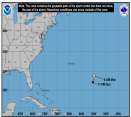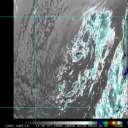The same is true for those on the other side of the debate, however -- they all only cite the same papers, over and over again. The SST link you show has nothing on the Pacific Ocean, which produces the most tropical cyclones globally. No one can explain what is going on there, which leaves a lot of open room for contention.
A reduced heat redistribution (e.g. weakened circulation) in the ocean would tend to pool warmer water in regions where it is already found -- so I don't think all of that is inconsistent with what you found. The reason there is a lot of uncertainty about both the AMO and what the others are saying is because we truly don't know what is going on. Historically, even with the faults in the dataset, there has been evidence on a long-term multi-decadal signal. If it's the AMO, if it's tied to the thermohaline circulation, great -- we don't know enough to really state that it is that. We also don't know enough to state that it is something else, either.
There's a recent article by two researchers at Purdue that shows a 34-40% variance explained in the trend in cyclone intensity as correlated with tropical SSTs. While they attempt to make use of the most objective data set available, the European Centre reanalysis, and acknowledge that this only holds for 1978-onward, there are two logic flaws. One, they show a substantial peak globally around 1985 instead of 1995 -- why is this the case? It's not addressed in their work or in Emanuel's previous work either. Two, the dataset only has a 1.125 degree horizontal resolution. Small storms are going to get lost or represented very poorly, even with improved data assimilation and additional satellite data, just because there are only a few grid points over them. Case in point -- Hurricane Andrew in 1992: at its peak intensity over the Bahamas, the reanalysis data set used had Andrew a little further south than it was in reality and with an intensity only of 1013mb/20kt. The metric they used relied on the wind speed cubed; given that smaller storms also tend to be a bit more intense at their peaks, there is a huge underestimate of these storms' intensity and integrated power using their method.
While I am willing to accept that more storms may equal more smaller storms from sheer numbers along, I don't believe there is a substantial trend in storm size in the dataset; it is more likely to be random noise than anything else, particularly when you consider that the global number of tropical cyclones is fairly constant from year to year (only minor variation noted). This is just one example; there are others. Even assuming their findings and general trend are correct, at best it accounts for 35-40% of the variance; something else is accounting for the other 60-65%.
I don't think anyone disagrees that climate change is occurring and that SSTs, on the whole, are warming. Where the disagreement comes is the acceleration of that by man -- anthropogenic climate change -- and I don't think there is any attempt to gang together and say that it is all due to multi-decadal signals. For one, more money is being funneled into climate science these days -- and inherently into the climate change issue. If politics were playing a role, so would money, and it is working in the opposite manner to what you suggest. Just my two cents.
--------------------
Current Tropical Model Output Plots
(or view them on the main page for any active Atlantic storms!)
|





 Flat
Flat


